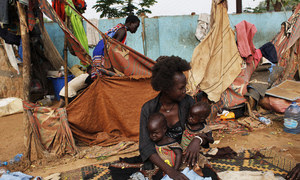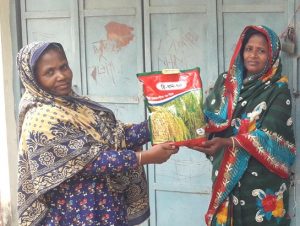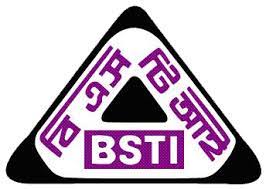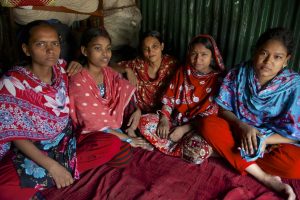Geneva, 20 May (Kanaga Raja) – Almost half of the population in the Central African Republic (CAR) are likely to suffer from high levels of acute food insecurity between April and August of this year, the United Nations Food and Agriculture Organization (FAO) and the United Nations World Food Programme (WFP) have said. According to the latest Integrated Food Security Phase Classification (IPC) analysis, in the coming months, 47% of the population in CAR will likely be in high acute food insecurity (IPC Phase 3 or above), representing around 2.29 million people.
According to FAO/WFP, 34% of the population analyzed, or 1.66 million people, are in a Crisis situation (IPC Phase 3), meaning that they may skip meals entirely or sell what little they own to buy food.
Nearly 633,000 people (13% of the population analyzed) are in an Emergency situation (IPC Phase 4), meaning that they may sell their last animal or last source of livelihood, pull their children out of school, or resort to begging.
[Populations in Crisis (IPC Phase 3), Emergency (IPC Phase 4) and Catastrophe (IPC Phase 5) are those in need of urgent action.]
“The people of the Central African Republic have been bearing the brunt of conflict for a decade, and food insecurity has been on the rise for the past years. Yet, never before has the food insecurity outlook been so dire,” said Perpetua Katepa-Kalala, FAO Representative in the Central African Republic.
“COVID-19 is keeping borders and markets closed or restricted, hampering the flow of food and driving its price up,” Katepa-Kalala added.
“Soon, the lean season will set in and rains will make the country’s dirt roads unusable. Delivering food, seeds for planting, and other essential supplies is only going to get tougher. It’s critical that we act fast,” Katepa-Kalala said.
“We need to break the vicious cycle of conflict and hunger in the Central African Republic. Never before have we seen so many people pushed right to the edge of survival – more than half a million people are one step away from famine. We urgently need to act now to save lives before it’s too late,” said Aline Rumonge, WFP Deputy Country Director in the Central African Republic.
FAO/WFP said that a deterioration of the situation has been observed in rural areas, where 49% of the population appears to be in Crisis or Emergency, of which 34% are in Crisis (IPC Phase 3) and 15% are in Emergency (IPC Phase 4).
The main factor driving food insecurity in CAR during this period is the violence experienced by the population following the conflicts that occurred on the fringes of the presidential and legislative elections in December 2020, said FAO/WFP.
“This violence has added to the civil insecurity that has affected the main sources of food and income for Central African households for almost a decade.”
According to the latest report by the Commission of Movement of Populations (CMP), as of 28 February 2021, some 741,879 people were internally displaced, an increase of 8.7% compared to December 2020, with 32% of the displaced population living in informal sites and 68% in host families.
FAO/WFP also said that the second wave of COVID-19 in sub-Saharan African countries threatens the Central African Republic.
It contributes to keeping market prices high and the population’s fear of contracting the disease, FAO/WFP added.
“This continues to negatively affect household incomes through loss of jobs and restricted movement, increasing vulnerability to food insecurity,” FAO/WFP said.
For example, FAO/WFP said the price of cassava rose by up to 60 percent between November 2020 and January 2021.
“The slowdown in trade flows caused by the COVID-19 measures has been exacerbated by the blocking of the Bouar-Garoua Boulai corridor by armed groups, causing unprecedented disruption to the supply of goods and humanitarian assistance.”
Furthermore, FAO/WFP said the 2020 harvests were disrupted by the deteriorating security situation, resulting in limited production and low food stock levels, which affected the populations who are heavily dependent on their own production.
This low production is also due to limited access to seeds, farming tools and basic infrastructure, said FAO/WFP.
Highlighting the degradation of basic infrastructure, FAO/WFP said that due to heavy rains, increased difficulties in supplying markets and physical access would be expected.
According to FAO/WFP, the historical evolution of the IPC results in the Central African Republic shows that the number of people in IPC Phase 3 or above has been on an upward trend in recent years, apart from the seasonal increase expected during the lean season.
A drop is particularly visible from May to August 2020, when nearly 2.4 million people appear to be in high acute food insecurity (IPC Phase 3 or above) – compared to an average of 1.7 million in previous analyses – with 754,000 people in Emergency (IPC Phase 4).
This deterioration can be partly explained by the impact of the COVID-19 pandemic on household food security, said FAO/WFP.
However, it seems to have slowed down over the last two periods analyzed, from September 2020 to April 2021 and April to August 2021, during which between 1.9 and 2.29 million people appear to be in high acute food insecurity (IPC Phase 3 or above), FAO/WFP added.
Among their recommendations, FAO/WFP called for the provision of immediate and targeted food assistance to the most vulnerable populations, in particular displaced persons, returnees and host families, prioritising people with specific needs (poor and very poor households, elderly people, people with chronic illnesses, HIV, etc).
FAO said that it needs USD 31.5 million to assist 970,000 vulnerable people in 2021 with life-saving support.
FAO said that it will distribute seeds and tools to help farmers make the most of the coming agricultural season; roll out a cash assistance programme; provide training in drought-resilient farming strategies and post-harvest loss reduction; and carry out vaccination campaigns to keep poultry, goats and sheep alive and support livestock production.
Meanwhile, WFP said it needs USD 54.9 million through September 2021 to continue providing life-saving food and nutrition assistance to almost a million crisis-affected people in the country. – Third World Network
Published in SUNS #9350 dated 21 May 2021




